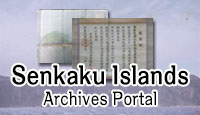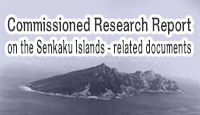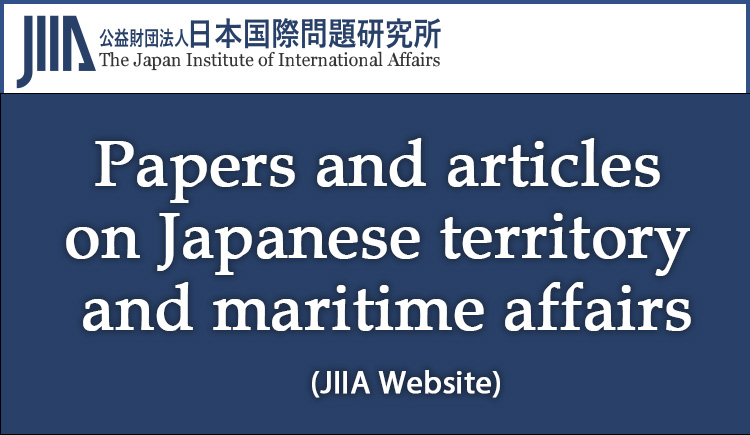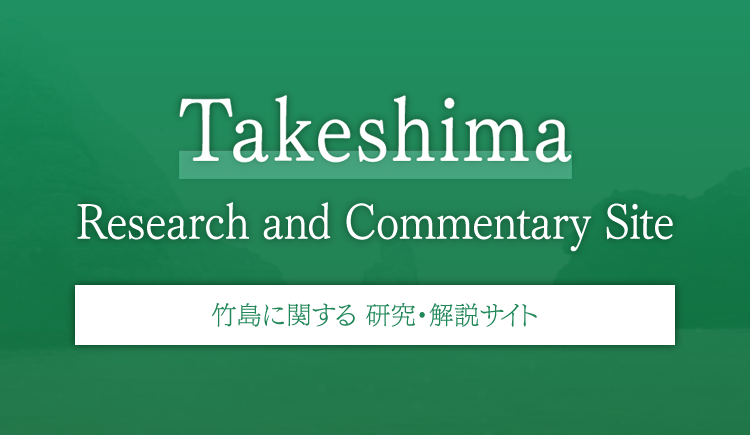The documents and materials published on this website were collected, researched, and prepared with advice from experts, as a part of a Government-commissioned project. The contents of this website do not reflect the views of the Government. Links to external sites (domains other than https://www.cas.go.jp) are not under the management of this site. For linked websites, please check with the organization/group that manages the website for the link in question.
Commentary on themes by historical period
Classification by historical periods III
From the Cabinet decision to
incorporate the Senkaku Islands into Japanese territory until the end of World War II
(1895-1945)
(3) Survey of the Senkaku Islands
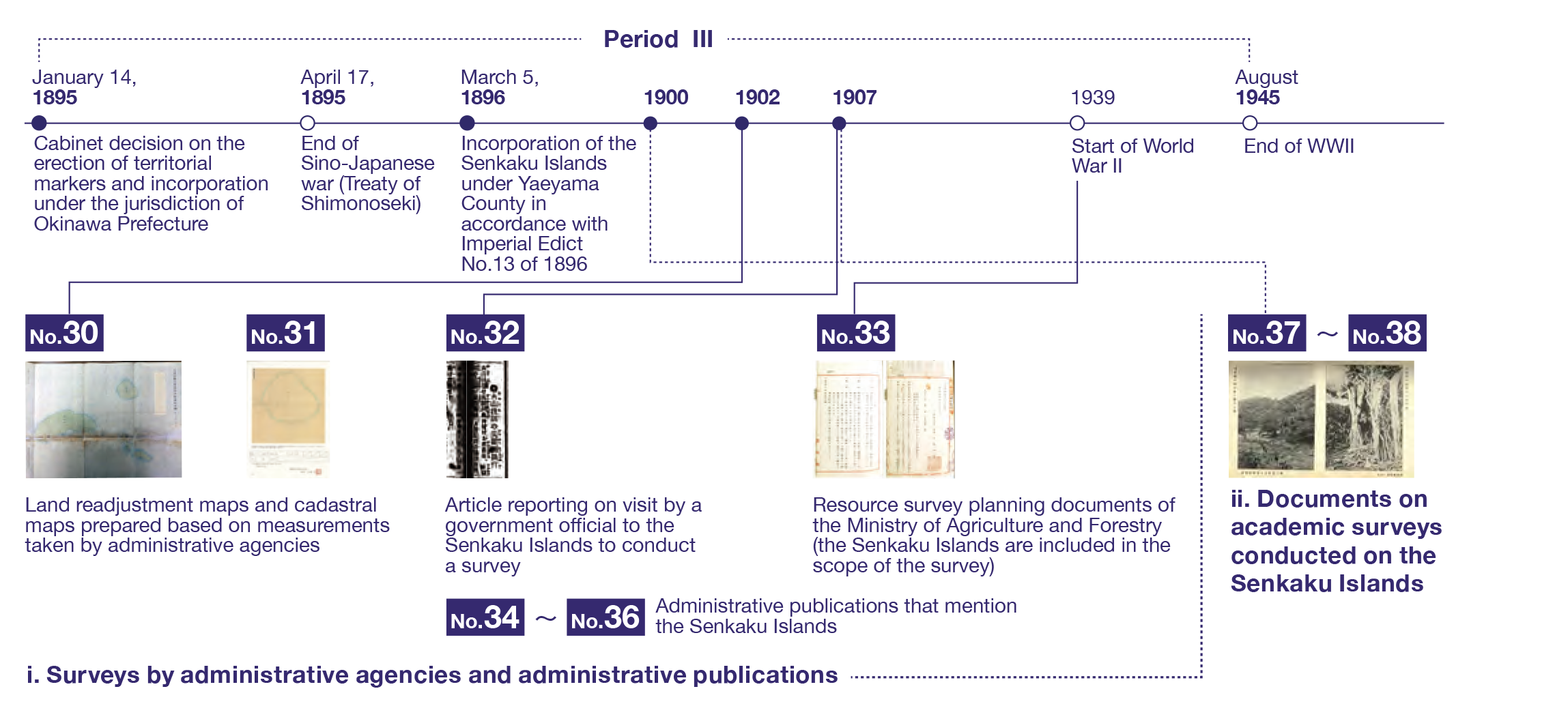
i. Surveys by administrative agencies and administrative publications
As has been explained, after the incorporation of the Senkaku Islands under the jurisdiction of
Okinawa Prefecture in 1895, Japan maintained valid control of the islands through the exercise of
administrative authority in various ways. These included surveys conducted by administrative
agencies, such as the taking of measurements of the Senkaku Islands through the Okinawa Prefecture
Temporary Land Consolidation Project in 1899No.30
No.31, and inspections of the Senkaku Islands by
government officials (*1).
According to our research carried out in FY2019, with regard to inspections of the Senkaku Islands
conducted by government officials, a newspaper article has been found pertaining to the visit to the
Senkaku Islands by an engineer (Yukichi OYAMA) from Okinawa PrefectureNo.32.
Thereafter, in 1939, the Ministry of Agriculture and Forestry conducted a resource survey, during
which the survey team (Jun KOBAYASHI, Naoyuki TAKAHASHI, and others) conducted a survey on the
Senkaku Islands alongside a technician from the Ishigaki Island Meteorological Office (Tsutomu
MASAKI) (*2). Planning documents for this resource survey have also been found through
our researchNo.33.
Other administrative publications were also foundNo.34
No.35
No.36.
ii. Academic surveys
During the Meiji era, two major academic surveys were conducted on the Senkaku Islands. The first was a survey of albatross on Kuba Island, conducted by Mikinosuke MIYAJIMA (Bachelor of Science, Tokyo Imperial University (currently University of Tokyo)). This survey was commissioned by Tatsushiro KOGA, who was concerned about the succession of his business in light of the sharp decline in the albatross population as a result of feather harvesting businesses.
MIYAJIMA conducted the survey with Hisashi KUROIWA (teacher at the Okinawa Prefectural Normal
School), and submitted an academic paper to the Journal of Geography reporting on the status
of development of Uotsuri and Kuba Islands, as well as their flora and faunaNo.37.
The second survey was conducted in June 1908 for the purpose of commercializing the mining of guano deposited on each of the islands of Senkaku. This was conducted by Noritaka TSUNETO (Doctor of Agriculture) at the invitation of KOGA.
The outcomes of the survey were compiled in Minami Nihon no Fugen (Rich Resources of Southern
Japan) (1901) published by TSUNETO. In later years, TSUNETO also touched on the survey of the
Senkaku Islands in his memoirsNo.38.
Our research has also confirmed that other academic surveys were also planned (*3). Most
of the academic surveys in the Meiji era were conducted by various experts at the invitation of
Tatsushiro KOGA, the developer of the Senkaku Islands.
Summary: Both the Japanese government and private sectors have been involved in the Senkaku Islands, such as through the surveys and management of the Senkaku Islands by administrative agencies and implementation of academic surveys by the private sector.
*1 The document related to the commendation of Tatsushiro KOGA, titled the “On the
matter of the bestowing of the Medal with Blue Ribbon,” included separate visits to the Senkaku
Islands made by an administrative official of Okinawa Prefecture (Gasho KISHIMOTO), a Secretary of
the Yaeyama Islands Public Office (Kenjiro NAKAJIMA), and the Chief of Yaeyama Police Station
(Kageharu MIYAHARA), respectively, on consecutive dates in 1904, as well as an inspection visit by
an engineer of Okinawa Prefecture (Yukichi OYAMA) in September 1907 and a joint inspection visit by
the Chief of Yaeyama Police (Sukematsu UCHIDA), a police inspector (Akira HARUTA), and one other
person in October 1907.
*2 MASAKI published a paper in 1941 reporting on the conditions on each island,
including their flora and fauna.
*3 On March 29, 1909, Ryukyu Shimpo, a local newspaper, reported on the scheduled
inspection of Kuba Island by Misao MATSUOKA (Bachelor of Agricultural Science) in April 1909, and
that the staff of Yokohama Nursery Co., Ltd. planned to inspect lilies cultivated on the Senkaku
Islands around the same period. (The title of the article is “Koga Inc.’s Cruise Ship to the
Uninhabited Islands.”) In addition, Kizo TAMARI (Doctor of Agricultural Science) inspected Kuba
Island and a katsuobushi (dried bonito) factory on Uotsuri Island in April 1910 (“Interview with
Kizo TAMARI – Tatsushiro KOGA’s Business on the Senkaku Islands,” Ryukyu Shimpo, dated April 19,
1910).
Senkaku Islands
Research and Commentary Site
- I Comprehensive issues
- II Commentary on themes by historical period
- III Analysis of claims by other countries

